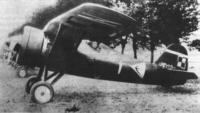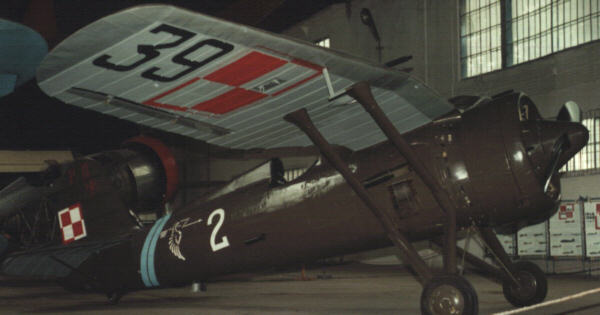|
|

|
The PZL P.1 prototype
|
The PZL P.11 was one of the line of fighters designed by Zygmunt Pulawski,
which, in the early thirties, for a short time brought Poland to the forefront
of fighter development. The basic concept of the line, which was first
realized in 1929 in the PZL P.1 prototype, was that of an aerodynamically
clean high-wing monoplane of all-metal construction. The characteristic
bent "gull-like" shape of the wings was adopted to reduce drag by eliminating
the need for any supporting structure between the center section and the
fuselage and, coupled with an in-line "Vee" engine, provided excellent
all-around visibility. An original "scissors" undercarriage design allowed
to hide shock absorbers in the fuselage, contributing further to the reduction
of drag. In the era of biplane fighters of usually mixed metal and wood,
fabric covered construction, the PZL P.1 was a revolutionary design. During
factory trials the first prototype fitted with Hispano-Suiza 12Lb engine
attained the speed of 295 km/h (183 mph), and in June of 1930, the second
prototype flown by Col. Kossowski took first place in 8 out of 15 various
trials during the international fighter contest in Bucharest, beating the
best British, French, German, Dutch and Czech designs of the time.
|

|
The PZL P.6 prototype photographed during the National Air Races in
Cleveland, 1931
|
In the same year 1929 it was decided that only air-cooled radial engines
would be produced in Poland, and this necessitated changes to the design.
As Bristol Jupiter engine had been selected for license production
in the Polish Skoda works, two new variants of the plane were prepared
- PZL P.6 with Jupiter VIFH engine, and PZL P.7 with the low-altitude
Jupiter VIF engine variant. Both of these featured new, semi-monocoque
fuselage. The PZL P.6 prototype, shown at the Paris International Air Show
in 1930 induced a great deal of international interest and in 1931, flown
by Boleslaw Orlinski, won the fighter contest during the National Air
Races in Cleveland, Ohio, Orlinski's breathtaking aerobatics leaving
the competition standing. It was however the PZL P.7/II (the second P.7
prototype) that was chosen, after trials, by the Lotnictwo Wojskowe,
and in 1931 orders for a total of 120 aircraft, designated PZL P.7a, were
placed. After overcoming production difficulties, first aircraft were accepted
into service in the end of 1932, the majority of the planes reaching the
units during 1933. Of the total of 149 airplanes delivered, 30 were still
in first-line units in September 1939, and their pilots managed to score
8.5 confirmed victories during the campaign, but as the plane was by then
totally obsolete and unsuitable for fighter combat, it was soon relegated
to reconnaissance duties. It was also flown by the instructors of the Fighter
Academy, who tried to organize a defense for the Deblin air base during
the first days of September, but they were unable to intercept German bombers
which were faster by a large margin.
|

|
The first PZL P.8 prototype (P.8/I)
|
Meanwhile, after the P.6 and P.7 prototypes were built, Pulawski designed
another prototype, the PZL P.8 which adhered to his original concept by
using the Hispano-Suiza 12Mc liquid-cooled in-line engine, the design having
the advantage of improved aerodynamics and visibility over its radial-powered
counterparts. Sadly, on 31 March 1931, Pulawski was killed while flying
the PZL-12H amphibian prototype of his own design, and even though two
P.8 prototypes were subsequently built, this elegant design was abandoned,
the officialdom being strongly biased in favor of radial engines.
Even before Pulawski's death, work had started on the PZL P.11, which
was to be a development of the P.6/P.7 redesigned to accept more powerful
Bristol Mercury engines. After the tragic accident, the development
of the fighter was entrusted to Wsiewolod Jakimiuk, and the first prototype,
temporarily fitted with Jupiter IXAsb engine, made its maiden flight
in the August of 1931. The prototype, flown by Orlinski during the international
fighter show in Istanbul again came ahead of its competition, the immediate
result being Romania's interest in the purchase of 60 aircraft and a license
to produce them at the IAR factory. The prototype was finally sold to Portugal,
which was also interested in the acquisition of Pulawski fighters.
|

|
A PZL P.7a of the 4th Air Regiment in 1932
|
The second prototype, fitted with Bristol Mercury IVA engine
was flown in December 1931, and attained the speed of 346 km/h (215 mph).
In June 1932, Gnome-Rhone, a French engine manufacturer offered an example
of its Mistral 9Kcr engine to PZL, planning to offer their engines
coupled with the PZL airframe to the French air force. While this resulted
later in the PZL P.24 prototype, the PZL P.11/II with the Gnome-Rhone engine
became the progenitor of the P.11b variant, intended for Romania. The agreement
with Romania was finalized in early 1933, and priority was given to the
fulfillment of that order, so the first 49 aircraft built were of the P.11b
variant, fitted with Mistral 9Ksrd engines, and the second prototype
became the 50th example of this type delivered to Romania. In the meantime,
the third prototype successfully completed trials in the spring of 1933,
and became the basis for the P.11a variant, 50 aircraft of this type, powered
by Mercury IVS2 engines, having been ordered by the Lotnictwo
Wojskowe.
|

|
The PZL P.11c prototype (P.11/IV) at the Paris Air Show in 1934
|
The PZL P.11c was designed in an attempt to improve visibility from
the cockpit, which was achieved by lowering the engine installation and
moving the pilot's seat upwards and back. The fuselage and tail were redesigned,
and the provision was made for installing additional two machine guns in
the wings (the PZL P.11a had two Vickers F 7.9mm machine guns in the fuselage).
175 airplanes were ordered, and delivered to the Lotnictwo Wojskowe
from 1934 to 1936 in two series, fitted with Polish license-built Bristol
Mercury VS2 and VIS2 engines. The P.11c prototype was later fitted
with Gnome-Rhone engine, and delivered to Romania, which acquired a license
and built 70 of these aircraft, designated PZL P.11f, during 1936-38 in
the IAR factory at Brasov.
|

|
P.11a of 114 Eskadra
|
Even though built in greatest numbers, the P.11 wasn't the ultimate
in the development of the Pulawski fighter line. Next fighter in the series,
the PZL P.24, whose second prototype broke the world speed record for fighter
planes with radial engines on 28 June 1934, attaining 414 km/h (257 mph),
was armed with two 20mm Oerlikon cannon and two 7.9mm machine guns. In
1934, it was advertised by the manufacturer as the "fastest and most powerfully
armed fighter in the world". It was a big export success in the Balkan
region, with Turkey, Bulgaria, Romania, and Greece ordering aircraft of
this type, and both Turkey and Romania acquiring manufacturing rights from
PZL. It was built in several variants, the most powerful being the P.24F
and G, both fitted with Gnome-Rhone 14N-07 970hp engine, differing only
in armament (the 'F' variant was armed with two 20mm cannon and 2 machine
guns, while the 'G' variant had four machine guns, all wing-mounted). By
the beginning of 1938, when the last of 36 of these aircraft were delivered
to Greece, it was becoming obvious that the future would belong to low-wing
fighters with retractable undercarriage, and any interest in the further
development of the line was abandoned by the PZL. The Romanian IAR factory,
however, used the P.24's rear fuselage and tail unit to design the IAR-80
low-wing fighter with retractable landing gear which, using basically the
same engine as the P.24, was about 100 km/h (62 mph) faster.
|

|
Turkish PZL P.24Cs at Warsaw Okecie airfield prior to delivery.
|
Interestingly enough, Lotnictwo Wojskowe never adopted the P.24
saying that its performance improvement over the P.11c was only marginal.
However, in early 1939, in view of the failure of both PZL P.38 Wilk
and PZL P.50 Jastrzab fighter projects on which Polish military
had pinned their hopes, PZL offered to manufacture Gnome-Rhone powered
fighters as a stop-gap measure, pending the procurement of modern fighters
from France and/or Great Britain. It was however decided that the available
Mercury VIII engines, initially intended for the P.50, would be
fitted to the P.11c airframe which, after minor redesign, resulted in the
PZL P.11g Kobuz prototype. None of these aircraft had been built
before the war broke out.
|

|
A PZL P.11a of 113 Eskadra in September 1939
|
In 1939, when Nazi Germany invaded Poland, the PZL P.11 was outclassed
in terms of performance by both Messerschmitt Bf 109 and Bf 110
fighters. It also had absolutely inadequate firepower, 70% of the aircraft
being equipped only with two 7.9 mm machine guns (and pilots often preferred
these over the four-machine gun version, saying that additional weight
affected the plane's performance - especially the climb rate!) It was,
however, very maneuverable and sturdy airplane, and its short take-off
facilitated operations from improvised airfields. A unique feature was
its jettisonable fuel tank. However, it had no armor protection for the
pilot. Throughout the September campaign P.11s operated in very difficult
conditions, with no repair facilities and inadequate spare parts supplies
(and all of them were 3 to 5 years old!). Despite of all these adversities,
P.11 pilots claimed almost 120 confirmed kills, including 10 Bf 109s and
13 Bf 110s. Only 26 P.11 fighters were destroyed in combat by German fighters
which, in view of German numerical and technical advantage is quite a low
number.
Pulawski fighters in foreign service also saw combat in WW2. Romanian
P.11f and P.11c aircraft (the P.11cs were the survivors of the Polish campaign)
were in front line units when Romania supported German thrust into Soviet
Union in 1941, as were the P.24Es. The latter were reportedly also scrambled
to meet American attacks on the Ploesti refinery in 1944, but, understandably,
enjoyed no success.
Greece had 36 P.24F and G aircraft in October 1940, when it was attacked
by Italy (most of the 20mm Oerlikon cannons having been removed, due to
problems with the acquisition of suitable ammunition in the war-torn Europe).
Despite of numerical disadvantage, difficult operating conditions and significant
combat attrition, these planes, flown by determined pilots, fared quite
well against the Reggia Aeronautica, and by 6 April 1941, when the
Luftwaffe entered the scene, 13 Pulawski fighters were still in
service, their pilots having claimed over 35 victories. They managed to
shoot down three German airplanes (a Ju 87 and two Hs 126) before April
23, when seven out of the remaining eight aircraft were destroyed on the
ground during German attack on the Amphiklia/Lodi airfield. |








